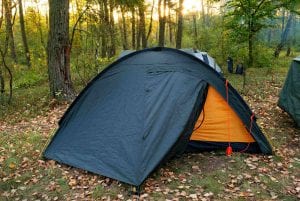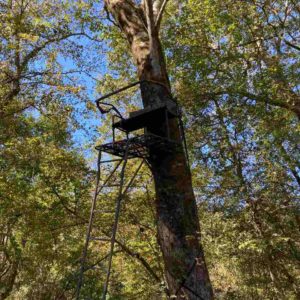
Gearing up for the outdoors can rapidly become an expensive game — and it doesn’t help that some of the most essential items come with the meatiest price tags.
Take down sleeping bags, for example.
The ability to sleep warm and comfortable can make or break a camping trip, but dropping $600 or more on an expedition-grade down sleeping bag just isn’t a possibility for many folk — especially if you’re just getting started in the world of open-air adventure.
Fortunately, there are some great mid-range options out there, and that’s what this article focuses on; some of the best down sleeping bags under $300. At this price, you can usually expect decent three-season warmth, backpacker-friendly pack weight, and perhaps even some waterproof treatments on the shell fabric or the down fill.
Read on for our pick of the bunch.
Mountain Hardwear Bishop Pass 15
Specs
Utilizing 650 fill-power down, the Bishop Pass 15 has a comfort rating of 26°F, with a lower limit of 15°F. A shaped draft collar and face gasket make sure the warmth stays in the bag, while a contoured foot box gives your feet plenty of wiggle room.
At 2lb 8oz, it’s a relatively lightweight bag. With its contoured mummy shape, it’s available in three sizes for campers up to 5’6″ (short), 6′ (regular), or 6’5″ (long).
The down itself hasn’t been treated for water-repellency, but the 30D nylon shell fabric has a durable water-repellent (DWR) treatment that should help protect the filling.
The Verdict
Warm, lightweight, and seriously good value for money, the Bishop Pass 15 is the best all-rounder on this list. It’s a solid three-season bag, but you could even nudge it into winter depending on where you’re using it.
As always, beware of the product name — since only the warmest sleepers will be able to take this bag down to 15°F without the cold getting its teeth into you. The comfort rating is actually 26°F, so you’re best off sticking in that ballpark unless you run especially hot.
Some online reviewers have found the fit quite snug, and, while the dimensions aren’t unusually lean for a backpacking bag, it’s worth noting that the Bishop Pass does feature a contoured mummy cut.
This shape is popular for hiking bags — since it maximizes warmth while skimming weight — but it can take a bit of getting used to if you haven’t slept in one before.
Availability
You should be able to pick one up from the following stores:
- Check prices at Sportsman’s Warehouse >>
Summary
An absolute winner for budget-conscious backpackers, the Mountain Hardwear Bishop Pass 15 offers three-season comfort at a fantastic price point.
Kelty Cosmic Down 20
Specs
The Kelty Cosmic Down 20 is a budget 3-season sleeping bag with a comfort rating of 32°F and a lower limit of 21°F. Stuffed with 550 fill-power duck down, it offers decent warmth at a relatively lightweight 2lb 10oz — and compresses down to 13” x 8”.
The 20D nylon shell fabric is treated with a durable water-repellent (DWR) coating for moisture resistance. Other features include a zippered internal stash pocket, a draft tube with anti-snag zipper, and a spacious foot box.
The Verdict
The Kelty Cosmic Down 20 sits squarely in the 3-season bracket. It’s a hugely popular model — and with a price tag like that, you can see why.
The Kelty costs two-thirds of most of the other bags on this list, with only minor sacrifices in warmth and weight. They’ve saved money by using duck down instead of goose, but at this fill-power there’s very little difference — and you’ll be pleasantly surprised by the dinky pack size.
While the down itself isn’t water-resistant, the DWR-treated shell is a real bonus.
Summary
The cheapest and most popular bag in our round-up, the Kelty Cosmic Down 20 is a lot of bang for your buck. While it’s not the warmest or lightest bag out there, it’s a fantastic pick for budget backpackers and casual campers.
Sierra Designs Nitro 35
Specs
At 1lb 6oz, the Sierra Designs Nitro 35 is a lightweight bag with a comfort rating of 37°F and a lower limit of 27°F. 800 fill-power down offers exceptional warmth for weight, and features a hydrophobic “DriDown” treatment.
A draft-collar keeps the warmth in during the night, while an innovative self-sealing foot vent means you can let excess heat out without having to unzip the side.
The Verdict
Seriously lightweight for the price, this bag weighs in at around half of most of the other models on our list.
Admittedly, it’s also not as warm as the rest — but unusually for a sleeping bag manufacturer, Sierra Designs have slightly under-egged the insulating performance of the Nitro 35.
You’ll notice that the lower limit is actually 27°F, so a warm sleeper could take it well below its marketed temperature.
It’s the 800 fill-power down that gives the Nitro such outstanding warmth for weight. Such high-quality down fill is very rare in a bag at this price — which makes it even more remarkable that it comes treated for water-resistance too.
According to the manufacturer, the “DriDown” used in this bag stays dry ten times longer than untreated down, dries 33% faster, and retains more insulation when wet.
If you’ve ever had to deal with a wet sleeping bag on the trail, you’ll know how valuable this is.
Summary
While not quite an “ultralight” sleeping bag, this is as close as you’ll get for the money. The Nitro 35 offers exceptional warmth for weight, with high-quality hydrophobic down that you’d expect to find in a much more expensive bag.
Nemo Disco 15
Specs
With a comfort rating of 25°F and a lower limit of 15°F, the Nemo Disco 15 is a roomy 3-season sleeping bag with a spoon shape that’s designed for side-sleepers. It’s relatively lightweight at 2lb 11oz, and packs down to 12″ x 9″.
It offers good water-resistance with 650 fill-power hydrophobic down, plus a water-resistant foot box.
Other features include front “Thermo Gills,” an overstuffed hood with “Blanket Fold” external draft collar, and an integrated pillow pocket.
The Verdict
Given that an estimated 60% of adults sleep on their side, it’s strange that more sleeping bag manufacturers aren’t working this into their product design. Enter Nemo, who reckon they’ve cracked the side-sleeper market with a “spoon” shape that gives you more space at the elbows and knees.
But that’s just the tip of the iceberg with the Disco 15 — because this is a bag with a lot of features.
There are the “Thermo Gill” vents that help you regulate heat and condensation without unzipping the bag, then the “Blanket Fold” draft collar — a sort of plush tongue that combines with an overstuffed hood to keep the heat where you want it.
Following that is the 650 fill-power down with a hydrophobic treatment to prevent water-related disasters. And we’re also huge fans of the waterproof foot box — having had more than one night ruined through tent condensation pooling round our toes.
Summary
A fully-featured bag that’s engineered for side-sleepers. Three-season performance, decent warmth for weight, and good waterproofing make this unconventional bag a popular pick for backpackers and hunters.
Kelty Cosmic Down 0
Specs
Stuffed with nearly 40oz of 550 fill-power duck down, the Kelty Cosmic Down 0 will keep most campers warm down to at least 17°F — with a lower limit of 4°F.
It weighs in at 4lb 9oz in total, and packs down to 10″ x 19″.
Features-wise, the 20D nylon shell is coated with a durable water-repellent (DWR) treatment, while a “natural fit” foot box allows extra space and warmth. There’s also a small internal pocket to keep your headlamp or cell phone.
The Verdict
Kelty markets this beefed-up version of the Cosmic Down as a three-season sleeping bag — but with a comfort rating of 17°F and a limit of 4°F, it’ll see many folk right through into the winter.
Add in a water-repellent shell to protect the down fill, and that price tag looks almost too good to be true.
The downside, of course, is the weight and the large pack size. The Cosmic Down 0 is nearly twice the weight of most backpacking bags, making it one for car campers rather than pack-rats.
Summary
The Kelty Cosmic Down 0 is too bulky and heavy for backpackers, but car campers can snag themselves serious cold-weather performance at an unbeatable price.
How to Choose the Best Down Sleeping Bag
Temperature Ratings
Hands-down, the most important aspect of a down sleeping bag is its warmth — which is usually expressed in terms of EN and ISO ratings.
Back in the day, manufacturers used their own individual systems to decide how warm a sleeping bag was — making it really difficult to compare different brands. 2005 saw the introduction of a universal assessment process called the EN 13537 standard, and in 2017 this was superseded by the ISO standard.
These ratings now mean that — at least in theory — we should be able to compare sleeping bags like-for-like.
The key thing to understand is that some of us sleep colder than others, so you can’t expect everyone to be comfortable in the same bag at the same temperature. It’s for this reason that temperature ratings are always expressed as three ranges: comfort, limit, and risk.
- The “comfort” range is the temperature band in which a cold sleeper would be comfortable. The lowest figure in this range is often called the “comfort rating.”
- The “transition” range is the temperature band in which a warmer sleeper might start to feel cold. The lowest figure in this range is known as the “limit.”
- Even warm sleepers will struggle in the “risk” range, and the lower you go, the greater the risk of hypothermia.
Inevitably, the existence of a standardized system doesn’t stop gear companies trying to big up their products.
A quick glance at sleeping bag names will show that many models are marketed on their lower limit rather than their comfort rating — despite the fact that most people will feel too cold if they try to use the bag in these temperatures.
Weight and Fill Power
No-one wants to carry a heavier load than they have to, and natural down insulation blows synthetic alternatives out of the water in terms of its warmth-to-weight ratio.
However, not all down is created equal — and that’s where fill power comes in.
Fill power measures the quality of down fill. Higher fill-power down will offer the same warmth for a smaller quantity of down, helping hikers whittle down their pack weight.
Fill power is much less important for car campers who don’t need to worry about their warmth-to-weight ratio, and who can instead focus on the warmth-to-cost ratio.
Cost
Some brands are pricier than others, but in general it’s the materials, fill-power, and features that will drive up the price of a sleeping bag. Ultimately, your choice of gear will be about finding a compromise between all these factors at a price you’re comfortable paying.
We’ve picked the $300 ballpark for this article because we reckon that’s the price point at which you can get a quality all-round bag without sacrificing too much in terms of weight and warmth.
Shape and Size
Most of the bags above feature a tailored mummy shape, which is the most popular for hiking bags. It skims weight and insulates well, but it can feel snug if you’re not used to it.
You’ll notice sleeping bags also tend to come in different lengths. Obviously, taller campers will feel more comfortable in longer bags (see here for some recommendations), but smaller individuals can also benefit from a shorter bag.
This is because a sleeping bag that’s too big for you will result in “dead space” which can sap your body heat, and manufacturers frequently offer a “short” size for people under 5’6”.
Water Resistance
Down and water aren’t best friends. When down gets wet, it loses its ability to loft up, making it next to useless as insulation.
Worse still, it takes forever to dry out — and accidentally ending up with a soaked sleeping bag on the trail can be miserable or even downright dangerous.
Some companies have come up with water-resistant treatments to try and get around this. The performance and qualities vary, but in general you’ll find these sleeping bags insulate better when wet, absorb less moisture, and dry much quicker than untreated down bags.
Some sleeping bags will also come with water-resistant shell fabrics, or may feature extra waterproofing in vulnerable areas like the foot box and hood.
Animal Welfare Considerations
In the last decade or so, investigations from animal welfare organizations have uncovered various grim and unethical practices in the down production industry.
Live plucking is the most notorious of these, but down has also been linked to foie gras production and other instances of animal cruelty.
After a lot of soul searching, the outdoor industry came up with a variety of initiatives to try and salvage its reputation, and the Responsible Down Standard (RDS) has emerged as the main industry standard for ethically sourced down.
Most manufacturers now use it, including all of those we’ve listed above.
FAQs
What is the warmest rated sleeping bag under $300?
The Kelty Cosmic Down 0 is the warmest sleeping bag on our list of the best sleeping bags under $300 — with a comfort rating of 17°F and a limit of 4°F.
How much is a good sleeping bag?
While top-quality sleeping bags can be much more expensive, $300 will get you a decent down sleeping bag that’s warm and light enough for three-season backpacking.
What is the best budget backpacking sleeping bag?
We think the Mountain Hardwear Bishop Pass 15 is the best backpacking sleeping bag around the $300 mark, but the Kelty Cosmic Down 20 offers great performance at an even lower price.
Should I get a 15 or 30 degree sleeping bag?
Which sleeping bag to get will depend on how warm you sleep and how much you can afford to spend, but in general it’s better to invest in a warmer bag if you can.





